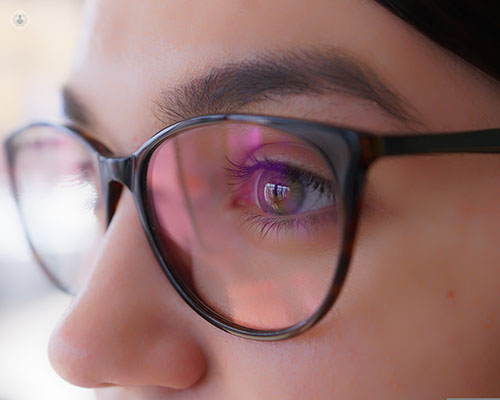Selective laser trabeculoplasty as a treatment for glaucoma
Written in association with:Mr Pieter Gouws is a highly-renowned ophthalmologist based in East Sussex. In his latest article, Mr Gouws explains how selective laser trabeculoplasty is used to treat glaucoma.

What is glaucoma?
Glaucoma is a neurodegenerative disease that causes the optic nerve to degenerate. It is normal for the optic nerve to degenerate over our lifetime, but it's normally at a very slow rate.
If we look at the average cohort of patients attending a clinic for glaucoma, we can see that the optic nerve degenerates much more quickly, especially if you are receiving no treatment for your glaucoma.
As it is a neurodegenerative disease, nerve tissue is dying away and nerve tissue doesn't regenerate, which means the change is permanent. There is huge variability in how rapidly this progresses over a patient’s lifetime, and it's important to identify if this is progressing very rapidly because you need to be treated more aggressively.
Lowering the eye pressure is still the primary goal for glaucoma treatment, and it's really key to understand a concept called Target IOP, which is intraocular pressure. The goal of treatment is to get the rate of progression low enough to where it's almost approaching the standard loss from ageing.
Of course, it can be quite difficult to determine exactly how far along you are. You need multiple tests and statistical analysis, but it's important to set a target and to revaluate if you are still progressing at this target. The target needs to be individualized and regularly revisited by your ophthalmologist.
How does the eye regulate pressure?
Fluid is made by a fleshy body behind the iris. This fluid goes from the ciliary body through the pupil. In the gap between the iris and the cornea, there's a fine sieve called the trabecular meshwork where the fluid drains away.

Up to 95% of all the drainage of fluid from the eye goes through this meshwork, into channels behind it, and then gets taken away. This is also the area where the main blockage occurs with most glaucoma patients, and if we can address that, we can significantly improve the pressure.
What is selective laser trabeculoplasty?
Selective laser trabeculoplasty is selective by definition. It is a very gentle laser compared to the old-style argon laser trabeculoplasty, where the laser actually caused structural damage. The selective laser trabeculoplasty is a gentle stimulation of the trabecular meshwork, and we treat all the way around the 360 degrees of the eye.
This causes a biological reaction. Inflammatory cells move into the trabecular meshwork and the debris blocking these gaps is cleared, facilitating normal drainage.

If you inspect the trabecular under a microscope, it can be seen that the old-style argon laser trabeculoplasty causes a big area of structural damage, whereas with selective laser trabeculoplasty, the trabecular looks completely normal.
Because it's a biological reaction, it can take one to three months to get the full results of your treatment, but we would expect to see a steady lowering of the intraocular pressure during this time.
There was an excellent study done in 2019 called the Light Study, which is the best study to date, comparing the conventional treatment for glaucoma using drops to selective laser trabeculoplasty. The study showed that patients who had SLT had better and more stable eye pressures. At their three-year outcome patients had not only better pressure control, but lower surgery rates, and almost three-quarters of the patients were completely drop-free with progression rates reduced by about 50%.
Not only did they not need glaucoma drainage surgeries, but they also had a lower rate of patients needing cataract surgery.
Most of these patients only needed one treatment with SLT, which also brings me to another point: that the treatment is repeatable. If you are one of the patients where the effect starts dwindling with time, it can be done again. There was only one patient that had a significant pressure spike in 776 patients.
The recommendation from this study was that SLT laser should be offered as a first-line treatment for patients with open-angle glaucoma or high pressure in the eye, supporting a change in clinical practice. SLT has been the first-line treatment in my personal practice for over three years now, and I've seen the same excellent results as in the Light Study.
What should I expect after SLT surgery?
On the day of the SLT laser procedure, you will have drops put in your eye to prepare the eye for the laser. These drops can make your vision blurry, and commonly cause a little bit of a headache across the top of the brow, which lasts for a few hours. The laser treatment itself is completely painless, and afterwards, you will receive some eye drops, usually for about five to seven days. These are to ensure that you don't develop any inflammatory response to the laser.

Is SLT surgery painful?
As it's a very gentle laser most patients don't feel anything at all. The eye has to be stabilized with a contact lens that is placed on the eye, which also has little mirrors in it, because the laser has to be aimed right in between the iris and the cornea, which is not accessible in any other way.
The person performing the laser will put some anaesthetic drops in the eye to make sure that the contact lens doesn't irritate it, and the laser itself shouldn't be felt. I have however had two or three patients over the years that said they did feel a little something and it was usually people with varied brown irises, so a lot of pigmentation. Although they felt something, they didn’t describe it as painful.
Mr Pieter Gouws is a leading ophthalmologist based in Hastings. If you are concerned about glaucoma, you can book a consultation with Mr Gouws today via his Top Doctors profile.


